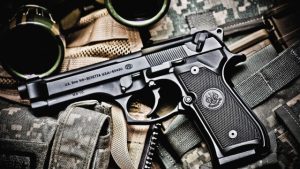Firearms have long been a topic of intense discussion and debate, fueling strong opinions from both sides of the argument. From personal protection and hunting to law enforcement and military usage, firearms hold a significant place in society. With ammunition being the lifeblood of these deadly weapons, it becomes crucial to explore the intricate world of firearms and understand the impact they have on our lives, both positive and negative. Let us delve into this complex and controversial topic, examining the various aspects surrounding firearms and the role they play in our modern world.
Types of Ammunition
Bullet Types
When it comes to firearms, understanding the various types of ammunition is crucial. One important aspect to consider is the different bullet types available. Bullet types are often distinguished by their purpose and design. For example, a Full Metal Jacket (FMJ) bullet is enclosed in a harder metal shell, offering reliable penetration and minimal expansion upon impact. On the other hand, Hollow Point (HP) bullets have a concave shape at the tip, causing them to expand upon impact and transfer more energy to the target. This makes HP bullets suitable for self-defense or hunting scenarios where controlled expansion is desired.
Caliber Variations
Apart from bullet types, the term "caliber" refers to the diameter of a bullet or the internal diameter of a firearm’s barrel. Different firearms are designed to accept specific calibers, ensuring proper fit and functionality. Caliber variations range from small, such as .22 caliber, to large, such as .50 caliber. Each caliber has its own characteristics and applications. Smaller calibers are often used for target shooting or small game hunting, while larger calibers are commonly utilized for long-range shooting or big game hunting.
Shotshell Types
In addition to bullets, shotshells are another important type of ammunition. Shotshells are predominantly used in shotguns and are specifically designed to disperse a large number of small pellets, or shot, upon firing. Shotshells come in different variations, including birdshot, buckshot, and slugs. Birdshot shells contain numerous small pellets, making them suitable for hunting birds or small game. Buckshot shells, on the other hand, are loaded with larger pellets, making them effective for self-defense or hunting larger animals. Lastly, slugs are solid projectiles that provide higher accuracy and are preferred for hunting larger game or for sporting purposes like slug-only competitions.
The variety of ammunition available for firearms ensures that enthusiasts, hunters, and law enforcement professionals can choose the type of ammunition that best suits their needs and intended use. Understanding the different bullet types, caliber variations, and shotshell types allows for a more informed and responsible approach to firearms usage.
Different Types of Firearms
There are various types of firearms available today, each designed for different purposes and with distinct features. In this section, we will explore some of the most common types of firearms.
Handguns:
Handguns, also known as pistols, are firearms designed to be held in one hand. They are typically smaller in size and are commonly used for self-defense, personal protection, and concealed carry. Handguns come in different variants, such as semi-automatic pistols and revolvers, each offering unique mechanisms for loading and firing ammunition.Rifles:
Rifles are long-barreled firearms that are usually fired from the shoulder. They are known for their accuracy and are commonly used for hunting, target shooting, and military or law enforcement purposes. Rifles can be further categorized into bolt-action, semi-automatic, or fully automatic rifles, with variations in magazine capacities, barrel lengths, and fire rates.Shotguns:
Shotguns are firearms that are designed to discharge a cluster of small pellets or a single slug. They are known for their wide spread and are popular for hunting small game, skeet shooting, and home defense. Shotguns come in various configurations, such as pump-action, semi-automatic, and break-action, with different barrel lengths and gauges, catering to different shooting preferences.
In conclusion, firearms are categorized into different types based on their design, functionality, and purpose. Handguns, rifles, and shotguns each serve a specific role and offer unique advantages depending on the situation at hand. Understanding these distinctions is essential for responsible firearm ownership and promoting safe shooting practices.
Gun Shops
Safety Measures and Regulations
In order to ensure the safe use and handling of firearms, various safety measures and regulations have been put in place. These guidelines are aimed at preventing accidents, promoting responsible ownership, and minimizing the risks associated with firearms.
First and foremost, it is crucial for anyone handling a firearm to have a thorough understanding of its mechanics and operation. This includes knowledge of how to properly load, unload, and handle the firearm, as well as how to engage and disengage any safety mechanisms. Training and education programs are available to teach individuals these important skills, helping to build a foundation of responsible firearm use.
In addition to personal responsibility, there are also legal regulations surrounding firearms. These laws vary from country to country and even within different regions, but they typically address factors such as the legal age for firearm ownership, background checks for prospective owners, and restrictions on the types of firearms and ammunition that can be purchased. By implementing these regulations, governments aim to ensure that firearms are only in the hands of responsible individuals who meet certain criteria.
Furthermore, proper storage and secure handling of firearms are essential safety measures. Firearms should be stored in a locked container, such as a gun safe, to prevent unauthorized access. Ammunition should be stored separately in a secure location. Additionally, it is important to never leave a loaded firearm unattended or within reach of children or individuals who are not properly trained in their use.
By adhering to these safety measures and regulations, individuals can help prevent accidents and promote responsible firearms ownership. Being knowledgeable about the mechanics and operation of firearms, understanding the legal regulations, and practicing secure storage and handling are all crucial steps toward fostering a safe environment for everyone involved in the world of firearms.







Recent Comments